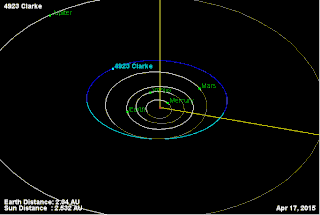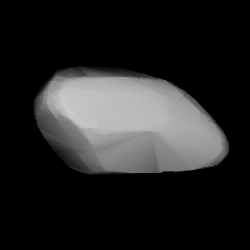Related Research Articles

15017 Cuppy, provisional designation 1998 SS25, is a Florian asteroid from the inner regions of the asteroid belt, approximately 2 kilometers in diameter. It was discovered on 22 September 1998, by the Lowell Observatory Near-Earth-Object Search (LONEOS) at its Anderson Mesa Station, Arizona, United States. The asteroid was named for American humorist Will Cuppy.

4923 Clarke, provisional designation 1981 EO27, is a stony background asteroid from the inner regions of the asteroid belt, approximately 3.5 kilometers (2.2 miles) in diameter. It was discovered on 2 March 1981, by American astronomer Schelte Bus at the Siding Spring Observatory in Australia. The spheroidal S-type asteroid has a rotation period of 3.14 hours. It was named after British science fiction writer Arthur C. Clarke. On the same night, Schelte Bus also discovered 5020 Asimov.
25924 Douglasadams (provisional designation 2001 DA42) is a Nysian asteroid from the inner regions of the asteroid belt, approximately 2.4 kilometers in diameter. It was discovered on 19 February 2001, by astronomers of the Lincoln Near-Earth Asteroid Research at the Lincoln Laboratory's Experimental Test Site in New Mexico, United States. The asteroid was named for novelist Douglas Adams.
2348 Michkovitch, provisional designation 1939 AA, is a presumed carbonaceous Erigone asteroid from the inner regions of the asteroid belt, approximately 15 kilometers in diameter. It was discovered by Serbian astronomer Milorad Protić at Belgrade Observatory on 10 January 1939. The asteroid was named after Serbian astronomer Vojislav Mišković.

9983 Rickfienberg is a carbonaceous asteroid from the middle region of the asteroid belt, approximately 10 kilometers in diameter. It was discovered on 19 February 1995, by American astronomer Dennis di Cicco at his private Sudbury Observatory, Massachusetts, United States. It was named after American astronomer and editor Richard Fienberg.
19738 Calinger (provisional designation 2000 AS97) is a background asteroid from the inner regions of the asteroid belt, approximately 3 kilometers in diameter.

9971 Ishihara is a stony Flora asteroid from the inner regions of the asteroid belt, approximately 5 kilometers in diameter. It was discovered by Japanese amateur astronomers Kin Endate and Kazuro Watanabe at Kitami Observatory on 16 April 1993, and named after Takahiro Ishihara, president of the astronomical society at Hiroshima.
14335 Alexosipov, provisional designation 1981 RR3, is a stony Flora asteroid from the inner regions of the asteroid belt, approximately 4 kilometers in diameter. It was discovered by Soviet–Russian astronomer Nikolai Chernykh at the Crimean Astrophysical Observatory in Nauchnyj, on 3 September 1981. The asteroid was named after astronomer Alexandr Osipov.
29292 Conniewalker (provisional designation 1993 KZ1) is a bright, stony Phocaea asteroid and slow tumbler from the inner regions of the asteroid belt, approximately 4.6 kilometers in diameter. It was discovered on 24 May 1993, by American astronomer Carolyn Shoemaker and Canadian astronomer David Levy at the Palomar Observatory in California, United States.
2173 Maresjev, provisional designation 1974 QG1, is a dark background asteroid from the outer regions of the asteroid belt, approximately 28 kilometers (17 miles) in diameter. It was discovered on 22 August 1974, by Soviet–Ukrainian astronomer Lyudmila Zhuravleva at the Crimean Astrophysical Observatory in Nauchnij, on the Crimean peninsula. It was named for Soviet war veteran Alexey Maresyev. The assumed C-type asteroid has a tentative rotation period of 11.6 hours.
9223 Leifandersson, provisional designation 1995 YY7, is a background asteroid from the inner regions of the asteroid belt, approximately 4.5 kilometers in diameter. It was discovered on 18 December 1995, by astronomers of the Spacewatch program at Kitt Peak National Observatory in Arizona, United States. The asteroid was named in memory of Swedish astronomer Leif Erland Andersson. The assumed stony asteroid has a rotation period of 3.758 hours.
5656 Oldfield, provisional designation A920 TA, is a background asteroid from the inner regions of the asteroid belt, approximately 7.7 kilometers in diameter. It was discovered on 8 October 1920, by astronomer Walter Baade at the Bergedorf Observatory in Hamburg, Germany. The asteroid was named for English musician Mike Oldfield.
14871 Pyramus, provisional designation 1990 TH7, is a dark Zhongguo asteroid from the outermost region of the asteroid belt, approximately 9 kilometers (6 miles) in diameter. It was discovered on 13 October 1990 by German astronomers Lutz Schmadel and Freimut Börngen at the Karl Schwarzschild Observatory in Tautenburg, Germany. The asteroid was named for Pyramus from classical mythology.
84882 Table Mountain (provisional designation 2003 CN16) is a bright background asteroid from the central region of the asteroid belt, approximately 3 kilometers (1.9 miles) in diameter. It was discovered on 1 February 2003, by American astronomer James Whitney Young at the Table Mountain Observatory near Wrightwood, California. The S/Q-type asteroid was later named after the discovering observatory.

45300 Thewrewk (provisional designation 2000 AF45) is a dark background asteroid from the outer regions of the asteroid belt, approximately 13 kilometers in diameter. It was discovered on 1 January 2000, by astronomers Krisztián Sárneczky and László Kiss at the Piszkéstető Station of the Konkoly Observatory in Hungary. The asteroid was named after Hungarian astronomer Aurél Ponori Thewrewk.
2278 Götz, provisional designation 1953 GE, is a dark background asteroid from the inner regions of the asteroid belt's background population, approximately 12 kilometers in diameter. It was discovered on 7 April 1953, by German astronomer Karl Reinmuth at the Heidelberg Observatory in southwest Germany. The F/C-type asteroid was named after astronomer Paul Götz.
4432 McGraw-Hill, provisional designation 1981 ER22, is a background asteroid from the inner regions of the asteroid belt, approximately 3 kilometers (2 miles) in diameter. It was discovered on 2 March 1981, by American astronomer Schelte Bus at the Siding Spring Observatory in Australia. The likely S-type asteroid was named for the McGraw-Hill Telescope located at Kitt Peak, Arizona.
37432 Piszkéstető (provisional designation 2002 AE11) is an Erigonian asteroid from the inner regions of the asteroid belt, approximately 4.6 kilometers (2.9 miles) in diameter. It was discovered on 11 January 2002, by the Hungarian astronomers Krisztián Sárneczky and Zsuzsanna Heiner at the Konkoly Observatory's Piszkéstető Station northeast of Budapest, Hungary. The asteroid was later named for the discovering observatory.
10140 Villon, provisional designation 1993 SX4, is a Nysian asteroid from the inner regions of the asteroid belt, approximately 5 kilometers (3 miles) in diameter. It was discovered on 19 September 1993, by Belgian astronomer Eric Elst at the CERGA Observatory at Caussols in France. It was named after 15th-century French poet François Villon.
30000 Camenzind (provisional designation 2000 AB138) is a very bright background asteroid from the inner region of the asteroid belt, approximately 2.6 kilometers (1.6 miles) in diameter. It was discovered on 4 January 2000, by astronomers of the Lincoln Near-Earth Asteroid Research program conducted at the Lincoln Laboratory's Experimental Test Site near Socorro, New Mexico, in the United States. The asteroid was named for 2014-ISTS awardee Kathy Camenzind.
References
- 1 2 3 4 5 6 "JPL Small-Body Database Browser: 19367 Pink Floyd (1997 XW3)" (2017-03-30 last obs.). Jet Propulsion Laboratory . Retrieved 13 September 2017.
- 1 2 3 Schmadel, Lutz D. (2006). "(19367) Pink Floyd [2.44, 0.16, 3.7]". Dictionary of Minor Planet Names – (19367) Pink Floyd, Addendum to Fifth Edition: 2003–2005. Springer Berlin Heidelberg. p. 134. doi:10.1007/978-3-540-34361-5_1491. ISBN 978-3-540-34361-5.
- 1 2 "Asteroid 19367 Pink Floyd – Proper Elements". AstDyS-2, Asteroids – Dynamic Site. Retrieved 29 October 2019.
- 1 2 3 Masiero, Joseph R.; Mainzer, A. K.; Grav, T.; Bauer, J. M.; Cutri, R. M.; Dailey, J.; et al. (November 2011). "Main Belt Asteroids with WISE/NEOWISE. I. Preliminary Albedos and Diameters". The Astrophysical Journal. 741 (2): 20. arXiv: 1109.4096 . Bibcode:2011ApJ...741...68M. doi:10.1088/0004-637X/741/2/68. S2CID 118745497 . Retrieved 13 September 2017.
- 1 2 "19367 Pink Floyd (1997 XW3)". Minor Planet Center. Retrieved 13 September 2017.
- ↑ "LCDB Data for (19367) Pink Floyd". Asteroid Lightcurve Database (LCDB). Retrieved 13 September 2017.
- ↑ "MPC/MPO/MPS Archive". Minor Planet Center. Retrieved 13 September 2017.